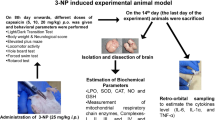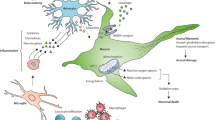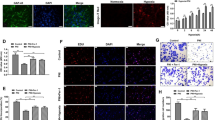Abstract
Oxidative stress and cytosolic Ca2+ overload have important roles on apoptosis in dorsal root ganglion (DRG) neurons after spinal cord injury (SCI). Hypericum perforatum (HP) has an antioxidant property in the DRGs due to its ability to modulate NADPH oxidase and protein kinase C pathways. We aimed to investigate the protective property of HP on oxidative stress, apoptosis, and Ca2+ entry through transient receptor potential melastatin 2 (TRPM2) and transient receptor potential vanilloid 1 (TRPV1) channels in SCI-induced DRG neurons of rats. Rats were divided into four groups as control, HP, SCI, and SCI + HP. The HP groups received 30 mg/kg HP for three concessive days after SCI induction. The SCI-induced TRPM2 and TRPV1 currents and cytosolic free Ca2+ concentration were reduced by HP. The SCI-induced decrease in glutathione peroxidase and cell viability values were ameliorated by HP treatment, and the SCI-induced increase in apoptosis, caspase 3, caspase 9, cytosolic reactive oxygen species (ROS) production, and mitochondrial membrane depolarization values in DRG of SCI group were overcome by HP treatment. In conclusion, we observed a protective role of HP on SCI-induced oxidative stress, apoptosis, and Ca2+ entry through TRPM2 and TRPV1 in the DRG neurons. Our findings may be relevant to the etiology and treatment of SCI by HP.

Possible molecular pathways of involvement of Hypericum perforatum (HP) on apoptosis, oxidative stress, and calcium accumulation through TRPM2 and TRPV1 channels in DRG neurons of SCI-induced rats. The TRPM2 channel is activated by ADP-ribose and oxidative stress through activation of ADP-ribose pyrophosphate although it was inhibited by N-(p-amylcinnamoyl) anthranilic acid (ACA) and 2-aminoethyl diphenylborinate (2APB). The TRPV1 channel is activated by oxidative stress and capsaicin and it is blocked by capsazepine. Injury in the DRG can result in augmented ROS release, leading to Ca2+ uptake through TRPM2 and TRPV1 channels. Mitochondria were reported to accumulate Ca2+, provided intracellular Ca2+ rises, thereby leading to depolarization of mitochondrial membranes and release of apoptosis-inducing factors such as caspase 3 and caspase 9. HP via regulation of NADPH oxidase and PKC inhibits TRPM2 and TRPV1 channels. The molecular pathway may be a cause of SCI-induced pain and neuronal death, and the subject should be urgently investigated.








Similar content being viewed by others
Abbreviations
- [Ca2+]c :
-
Intracellular free calcium ion concentration
- 2-APB:
-
2-Aminoethyl diphenylborinate
- ACA:
-
N-(p-Amylcinnamoyl) anthranilic acid
- CAP:
-
Capsaicin
- CPZ:
-
Capsazepine
- DRG:
-
Dorsal root ganglion
- HP:
-
Hypericum perforatum
- LP:
-
Lipid peroxidation
- ROS:
-
Reactive oxygen species
- SCI:
-
Spinal cord injury
- TRP:
-
Transient receptor potential
- TRPM2:
-
Transient receptor potential melastatin 2
- TRPV1:
-
Transient receptor potential vanilloid 1
- WC:
-
Whole cell
References
Nazıroğlu M (2007) New molecular mechanisms on the activation of TRPM2 channels by oxidative stress and ADP-ribose. Neurochem Res 32:1990–2001
Nazıroğlu M, Özgül C (2013) Vitamin E modulates oxidative stress and protein kinase C activator (PMA)-induced TRPM2 channel gate in dorsal root ganglion of rats. J Bioenerg Biomembr 45(6):541–549
Nazıroğlu M, Senol N, Ghazizadeh V, Yürüker V (2014) Neuroprotection induced by N-acetylcysteine and selenium against traumatic brain injury-induced apoptosis and calcium entry in hippocampus of rat. Cell Mol Neurobiol 34:895–903
Nazıroğlu M, Çiğ B, Özgül C (2014) Modulation of oxidative stress and Ca(2+) mobilization through TRPM2 channels in rat dorsal root ganglion neuron by Hypericum perforatum. Neuroscience 263:27–35
Liu JM, Yi Z, Liu SZ, Chang JH, Dang XB, Li QY, Zhang YL (2015) The mitochondrial division inhibitor mdivi-1 attenuates spinal cord ischemia-reperfusion injury both in vitro and in vivo: involvement of BK channels. Brain Res S0006–8993(15):00230–00239
Kumar VS, Gopalakrishnan A, Naziroğlu M, Rajanikant GK (2014) Calcium ion—the key player in cerebral ischemia. Curr Med Chem 21:2065–2075
Nazıroğlu M, Dikici DM, Dursun S (2012) Role of oxidative stress and Ca(2+) signaling on molecular pathways of neuropathic pain in diabetes: focus on TRP channels. Neurochem Res 37:2065–2075
Cook NL, Vink R, Helps SC, Manavis J, van den Heuvel C (2010) Transient receptor potential melastatin 2 expression is increased following experimental traumatic brain injury in rats. J Mol Neurosci 42:192–199
Wu KL, Hsu C, Chan JY (2009) Nitric oxide and superoxide anion differentially activate poly(ADP-ribose) polymerase-1 and Bax to induce nuclear translocation of apoptosis-inducing factor and mitochondrial release of cytochrome c after spinal cord injury. J Neurotrauma 26:965–977
Hara Y, Wakamori M, Ishii M, Maeno E, Nishida M, Yoshida T, Yamada H, Shimizu S et al (2002) LTRPC2 Ca2+-permeable channel activated by changes in redox status confers susceptibility to cell death. Mol Cell 9:163–173
Susankova K, Tousova K, Vyklicky L, Teisinger J, Vlachova V (2006) Reducing and oxidizing agents sensitize heat-activated vanilloid receptor (TRPV1) current. Mol Pharmacol 70(1):383–394
Nazıroğlu M, Lückhoff A (2008) Effects of antioxidants on calcium influx through TRPM2 channels in transfected cells activated by hydrogen peroxide. J Neurol Sci 270:152–158
Nazıroğlu M, Lückhoff A (2008) A calcium influx pathway regulated separately by oxidative stress and ADP-ribose in TRPM2 channels: single channel events. Neurochem Res 33:1256–1262
Nishio N, Taniguchi W, Sugimura YK, Takiguchi N, Yamanaka M, Kiyoyuki Y, Yamada H, Miyazaki N et al (2013) Reactive oxygen species enhance excitatory synaptic transmission in rat spinal dorsal horn neurons by activating TRPA1 and TRPV1 channels. Neuroscience 247:201–212
Miyake T, Shirakawa H, Kusano A, Sakimoto S, Konno M, Nakagawa T, Mori Y, Kaneko S (2014) TRPM2 contributes to LPS/IFNγ-induced production of nitric oxide via the p38/JNK pathway in microglia. Biochem Biophys Res Commun 444:212–217
Galeotti N, Vivoli E, Bilia AR, Vincieri FF, Ghelardini C (2010) St. John’s Wort reduces neuropathic pain through a hypericin-mediated inhibition of the protein kinase C gamma and epsilon activity. Biochem Pharmacol 79:1327–1336
Nazıroglu M, Kutluhan S, Ovey IS, Aykur M, Yurekli VA (2014) Modulation of oxidative stress, apoptosis, and calcium entry in leukocytes of patients with multiple sclerosis by Hypericum perforatum. Nutr Neurosci 17(5):214–221
Nazıroğlu M, Sahin M, Ciğ B, Aykur M, Erturan I, Ugan Y (2014) Hypericum perforatum modulates apoptosis and calcium mobilization through voltage-gated and TRPM2 calcium channels in neutrophil of patients with Behcet’s disease. J Membr Biol 247:253–262
Krishtal O, Lozovaya N, Fisunov A, Tsintsadze T, Pankratov Y, Kopanitsa M, Chatterjee SS (2001) Modulation of ion channels in rat neurons by the constituents of Hypericum perforatum. Pharmacopsychiatry 34(Suppl 1):S74–S82
Kumar V, Mdzinarishvili A, Kiewert C, Abbruscato T, Bickel U, van der Schyf CJ, Klein J (2006) NMDA receptor-antagonistic properties of hyperforin, a constituent of St John’s Wort. J Pharmacol Sci 102(1):47–54
Vance KM, Ribnicky DM, Hermann GE, Rogers RC (2014) St. John’s Wort enhances the synaptic activity of the nucleus of the solitary tract. Nutrition 30(7–8 Suppl):S37–S42
Zanoli P, Rivasi M, Baraldi C, Baraldi M (2002) Pharmacological activity of hyperforin acetate in rats. Behav Pharmacol 13(8):645–651
Rivlin AS, Tator CH (1978) Effect of duration of acute spinal cord compression in a new acute cord injury model in the rat. Surg Neurol 10:38–43
Nazıroğlu M, Uğuz AC, Ismailoğlu Ö, Çiğ B, Özgül C, Borcak M (2013) Role of TRPM2 cation channels in dorsal root ganglion of rats after experimental spinal cord injury. Muscle Nerve 48(6):945–950
Övey IS, Nazıroğlu M (2015) Homocysteine and cytosolic GSH depletion induce apoptosis and oxidative toxicity through cytosolic calcium overload in the hippocampus of aged mice: involvement of TRPM2 and TRPV1 channels. Neuroscience 284:225–233
Nazıroğlu M, Övey IS (2015) Involvement of apoptosis and calcium accumulation through TRPV1 channels in neurobiology of epilepsy. Neuroscience 293:55–66
Bejarano I, Redondo PC, Espino J, Rosado JA, Paredes SD, Barriga C, Reiter RJ, Pariente JA et al (2009) Melatonin induces mitochondrial-mediated apoptosis in human myeloid HL-60 cells. J Pineal Res 46:392–400
Espino J, Bejarano I, Redondo PC, Rosado JA, Barriga C, Reiter RJ, Pariente JA, Rodríguez AB (2010) Melatonin reduces apoptosis induced by calcium signaling in human leukocytes: evidence for the involvement of mitochondria and Bax activation. J Membr Biol 233:105–118
Grynkiewicz C, Poenie M, Tsien RY (1985) A new generation of Ca2+ indicators with greatly improved fluorescence properties. J Biol Chem 260:3440–3450
Uğuz AC, Cig B, Espino J, Bejarano I, Nazıroğlu M, Rodríguez AB, Pariente JA (2012) Melatonin potentiates chemotherapy-induced cytotoxicity and apoptosis in rat pancreatic tumor cells. J Pineal Res 53:91–98
Heemskerk JW, Feijge MA, Henneman L, Rosing J, Hemker HC (1997) The Ca2+-mobilizing potency of alpha-thrombin and thrombin receptor-activating peptide on human platelets concentration and time effects of thrombin-induced Ca2+ signalling. Eur J Biochem 249:547–555
Placer ZA, Cushman L, Johnson BC (1966) Estimation of products of lipid peroxidation (malonyl dialdehyde) in biological fluids. Anal Biochem 16:359–364
Sedlak J, Lindsay RHC (1968) Estimation of total, protein bound and non-protein sulfhydryl groups in tissue with Ellmann’ s reagent. Anal Biochem 25:192–205
Tök L, Nazıroğlu M, Uğuz AC, Tök O (2014) Elevated hydrostatic pressures induce apoptosis and oxidative stress through mitochondrial membrane depolarization in PC12 neuronal cells: a cell culture model of glaucoma. J Recept Signal Transduct Res 34:410–416
Lawrence RA, Burk RF (1976) Glutathione peroxidase activity in selenium-deficient rat liver. Biochem Biophys Res Commun 71:952–958
Akpinar A, Uğuz AC, Nazıroğlu M (2014) Agomelatine and duloxetine synergistically modulates apoptotic pathway by inhibiting oxidative stress triggered intracellular calcium entry in neuronal PC12 cells: role of TRPM2 and voltage-gated calcium channels. J Membr Biol 247:451–459
Sakurai E, Kurihara T, Kouchi K, Saegusa H, Zong S, Tanabe T (2009) Upregulation of casein kinase 1epsilon in dorsal root ganglia and spinal cord after mouse spinal nerve injury contributes to neuropathic pain. Mol Pain 5:74
Özgül C, Nazıroğlu M (2012) TRPM2 channel protective properties of N-acetylcysteine on cytosolic glutathione depletion dependent oxidative stress and Ca2+ influx in rat dorsal root ganglion. Physiol Behav 106:122–128
Wang S, Joseph J, Ro JY, Chung MK (2015) Modality-specific mechanisms of PKC-induced hypersensitivity of TRPV1: S800 is a polymodal sensitization site. Pain. 2015
Ito N, Ruegg UT, Kudo A, Miyagoe-Suzuki Y, Takeda S (2013) Activation of calcium signaling through Trpv1 by nNOS and peroxynitrite as a key trigger of skeletal muscle hypertrophy. Nat Med 19(1):101–106
Ibi M, Matsuno K, Shiba D, Katsuyama M, Iwata K, Kakehi T, Nakagawa T, Sango K et al (2008) Reactive oxygen species derived from NOX1/NADPH oxidase enhance inflammatory pain. J Neurosci 28:9486–9494
Genovese T, Mazzon E, Menegazzi M, Di Paola R, Muià C, Crisafulli C, Bramanti P, Suzuki H et al (2006) Neuroprotection and enhanced recovery with hypericum perforatum extract after experimental spinal cord injury in mice. Shock 25(6):608–617
Chang Y, Wang SJ (2010) Hypericin, the active component of St. John’s wort, inhibits glutamate release in the rat cerebrocortical synaptosomes via a mitogen-activated protein kinase-dependent pathway. Eur J Pharmacol 634:53–61
Pei Z, Zhuang Z, Sang H, Wu Z, Meng R, He EY, Scott GI, Maris JR et al (2014) α, β-Unsaturated aldehyde crotonaldehyde triggers cardiomyocyte contractile dysfunction: role of TRPV1 and mitochondrial function. Pharmacol Res 82:40–50
Heilmann J, Winkelmann K, Sticher O (2003) Studies on the antioxidative activity of phloroglucinol derivatives isolated from hypericum species. Planta Med 69:202–206
Wu Z, Yang Q, Crook RJ, O’Neil RG, Walters ET (2013) TRPV1 channels make major contributions to behavioral hypersensitivity and spontaneous activity in nociceptors after spinal cord injury. Pain 154:2130–2141
Tzellos TG, Papazisis G, Amaniti E, Kouvelas D (2008) Efficacy of pregabalin and gabapentin for neuropathic pain in spinal-cord injury: an evidence-based evaluation of the literature. Eur J Clin Pharmacol 64(9):851–858
Acknowledgments
The authors thank Dr. Peter J Butterworth (King’s College, London, UK) for helpful discussions on the manuscript. In addition, the authors thank Muhammet Şahin, technician Fatih Şahin, and research assistant Bilal Çiğ for helping with antioxidant analysis, patch-clamp analyses, and graphical abstract revision.
Conflict of Interest
The authors declare that there is no conflict of interest in the current study.
Financial Disclosure
The study was partially supported by the Unit of Scientific Research Project, Suleyman Demirel University (NO: BAP: 3266-TU2-12). There is no financial disclosure for the current study.
Author Contributions
MN and NŞ formulated the present hypothesis and were responsible for writing the report. ÜSÖ was responsible for induction of SCI. VG was responsible for DRG isolation and cytosolic Ca2+ release analyses.
Author information
Authors and Affiliations
Corresponding author
Rights and permissions
About this article
Cite this article
Özdemir, Ü.S., Nazıroğlu, M., Şenol, N. et al. Hypericum perforatum Attenuates Spinal Cord Injury-Induced Oxidative Stress and Apoptosis in the Dorsal Root Ganglion of Rats: Involvement of TRPM2 and TRPV1 Channels. Mol Neurobiol 53, 3540–3551 (2016). https://doi.org/10.1007/s12035-015-9292-1
Received:
Accepted:
Published:
Issue Date:
DOI: https://doi.org/10.1007/s12035-015-9292-1




